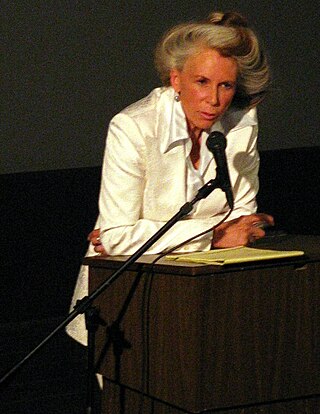
Hardcore pornography or hardcore porn is pornography that features detailed depictions of sexual organs or sexual acts such as vaginal, anal, oral or manual intercourse, ejaculation, and fetish play. The term is in contrast with less-explicit softcore pornography. Hardcore pornography usually takes the form of photographs, films, and cartoons. Since the mid-1990s, hardcore pornography has become widely available on the internet, making it more accessible than ever before.

Pornography has existed since the origins of the United States, and has become more readily accessible in the 21st century. Advanced by technological development, it has gone from a hard-to-find "back alley" item, beginning in 1969 with Blue Movie by Andy Warhol, the Golden Age of Porn (1969–1984) and home video, to being more available in the country and later, starting in the 1990s, readily accessible to nearly anyone with a computer or other device connected to the Internet. The U.S. has no current plans to block explicit content from children and adolescents, as many other countries have planned or proceeded to do.

Catharine Alice MacKinnon is an American feminist legal scholar, activist, and author. She is the Elizabeth A. Long Professor of Law at the University of Michigan Law School, where she has been tenured since 1990, and the James Barr Ames Visiting Professor of Law at Harvard Law School. From 2008 to 2012, she was the special gender adviser to the Prosecutor of the International Criminal Court.

R18 is a film or video classification given by the British Board of Film Classification (BBFC). It is intended to provide a classification for works that do not breach UK law, but exceed what the BBFC considers acceptable in the 18 category. In practice, this means hardcore pornography.

Pornography laws by region vary throughout the world. The production and distribution of pornographic films are both activities that are legal in some but not all countries, as long as the pornography features performers aged above a certain age, usually 18 years. Further restrictions are often placed on such material.
Stanley v. Georgia, 394 U.S. 557 (1969), was a landmark decision of the Supreme Court of the United States that helped to establish an implied "right to privacy" in U.S. law in the form of mere possession of obscene materials.

Pornography has been dominated by a few pan-European producers and distributors, the most notable of which is the Private Media Group that successfully claimed the position previously held by Color Climax Corporation in the early 1990s. Most European countries also have local pornography producers, from Portugal to Serbia, who face varying levels of competition with international producers. The legal status of pornography varies widely in Europe; its production and distribution are illegal in countries such as Ukraine, Belarus and Bulgaria, while Hungary has liberal pornography laws.

R v Butler, [1992] 1 S.C.R. 452 is a leading Supreme Court of Canada decision on pornography and state censorship. In this case, the Court had to balance the right to freedom of expression under section 2 of the Canadian Charter of Rights and Freedoms with women's rights. The outcome has been described as a victory for anti-pornography feminism and the Women's Legal Education and Action Fund, but a loss for alternative sexualities.

R v Labaye, [2005] 3 S.C.R. 728, 2005 SCC 80, was a decision by the Supreme Court of Canada on criminal indecency. The decision upheld consensual group sex and swinging activities in a club and alleged bawdy-house as being consistent with personal autonomy and liberty. Labaye was accompanied by a sister case, R v Kouri.
The Anti-pornography Civil Rights Ordinance is a name for several proposed local ordinances in the United States and that was closely associated with the anti-pornography radical feminists Andrea Dworkin and Catharine A. MacKinnon. It proposed to treat pornography as a violation of women's civil rights and to allow women harmed by pornography to seek damages through lawsuits in civil courts. The approach was distinguished from traditional obscenity law, which attempts to suppress pornography through the use of prior restraint and criminal penalties.

Pornography has been defined as sexual subject material "such as a picture, video, or text" that is intended for sexual arousal. Intended for consumption by adults, pornography depictions have evolved from cave paintings, some forty millennia ago, to virtual reality presentations. A general distinction of adult content is made classifying it as pornography or erotica.
The National Center on Sexual Exploitation (NCOSE), previously known as Morality in Media and Operation Yorkville, is an American conservative anti-pornography organization. The group has also campaigned against sex trafficking, same-sex marriage, sex shops and sex toys, decriminalization of sex work, comprehensive sex education, and various works of literature or visual arts the organization has deemed obscene, profane or indecent. Its current president is Patrick A. Trueman. The organization describes its goal as "exposing the links between all forms of sexual exploitation".
An obscenity is any utterance or act that strongly offends the prevalent morality of the time. It is derived from the Latin obscēnus, obscaenus, "boding ill; disgusting; indecent", of uncertain etymology. Generally, the term can be used to indicate strong moral repugnance and outrage in expressions such as "obscene profits" and "the obscenity of war". As a legal term, it usually refers to descriptions and depictions of people engaged in sexual and excretory activity.
Much of the regulation in the adult film industry has been limited to preventing child pornography. To enforce the age of entry restriction, most adult industry production companies are required to have a Custodian of Records that documents and holds records of the ages of all performers.
Simulated child pornography is child pornography depicting what appear to be minors but which is produced without their direct involvement.
Feminist views on pornography range from total condemnation of the medium as an inherent form of violence against women to an embracing of some forms as a medium of feminist expression. This debate reflects larger concerns surrounding feminist views on sexuality, and is closely related to those on prostitution, BDSM, and other issues. Pornography has been one of the most divisive issues in feminism, particularly in Anglophone (English-speaking) countries. This division was exemplified in the feminist sex wars of the 1980s, which pitted anti-pornography activists against pro-pornography ones.
An anti-pornography movement in the United States has existed since before the 1969 Supreme Court decision of Stanley v. Georgia, which held that people could view whatever they wished in the privacy of their own homes, by establishing an implied "right to privacy" in U.S. law. This led President Lyndon B. Johnson, with the backing of Congress, to appoint a commission to study pornography. The anti-pornography movement seeks to maintain or restore restrictions and to increase or create restrictions on the production, sale or distribution of pornography.

Pornography in Turkey has been produced since the 1970s. In fact, Turkey remains just one of two Middle Eastern countries where porn is not banned outright, including Israel. According to a presentation on the "conscious use of the Internet and secure Internet service," made by the Telecommunications Department (TIB) of the Turkish Parliament, 2 million online users watch pornographic films each minute in Turkey.

R v Peacock was an English Crown Court case that was a test of the Obscene Publications Act 1959. In December 2009, the defendant, a male escort named Michael Peacock, had been charged by the Metropolitan Police for selling hardcore gay pornography that the police believed had the ability to "deprave or corrupt" the viewer, which was illegal under the Obscene Publications Act. He was subsequently acquitted through a trial by jury in January 2012.
United States obscenity law deals with the regulation or suppression of what is considered obscenity and therefore not protected speech or expression under the First Amendment to the United States Constitution. In the United States, discussion of obscenity typically relates to defining what pornography is obscene, as well as to issues of freedom of speech and of the press, otherwise protected by the First Amendment to the Constitution of the United States. Issues of obscenity arise at federal and state levels. State laws operate only within the jurisdiction of each state, and there are differences among such laws. Federal statutes ban obscenity and child pornography produced with real children. Federal law also bans broadcasting of "indecent" material during specified hours.








